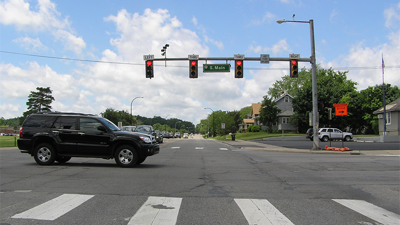Traffic signs and pavement markings
Traffic signs and pavement markings are used to direct various modes of transportation that use the roadways in the City of Ann Arbor.
Traffic control signs include:
- intersection control (Stop and Yield)
- lane usage control (Right Lane Must Turn Right, etc.)
- movement prohibition (No U-Turn, etc.)
- speed limit
- parking signs
In addition to separating opposing traffic and designating lanes for traffic moving in the same direction, pavement markings:
- designate where pedestrians are to cross the street (crosswalks)
- indicate where drivers should stop their vehicles (stop bars)
- complement lane usage control signs (turn and through arrows).
The City installs traffic control devices only in accordance with the Michigan Manual of Uniform Traffic Control Devices (MMUTCD). The MMUTCD is the legal standard for uniform traffic control devices in the state of Michigan. The manual provides standards for installation, sometimes referred to as "warrants," as well as sign placement and size.
Traffic signals
Traffic signals in Ann Arbor fall into two general categories: coordinated and non-coordinated. There are benefits to each type of operation.
Coordinated Signals: When intersections are close together, coordinating traffic signals allow traffic to move through several intersections without being stopped
Fully actuated Signals: When intersections are further apart, the group of cars starting from the first signal as a closely spaced "platoon" spreads apart. It becomes very difficult to say for which cars the green should be displayed on the next signal: for the few fastest that first arrive, or for the bigger group in the middle. In this case the actuated controller works the best, adjusting signal phases to the volume of traffic approaching the intersection.
Coordination of traffic signals is maintained in our city using a central computer connected to great majority of our signals.
The central computer system was rebuilt in 1997 and upgraded several times since. A modern fiber optic communication network connects intersection controllers with central computers. Some segments of our network that do not have fiber, are connected using radio communication. There are still eight signals that are not connected to the central computer. The computer uses TACTICS software from Siemens. The central computer communicates with individual intersections, checking their status, comparing signal internal clocks with the central computer's clock, collecting data and changing timing plans. We can monitor the performance of the system, change the settings of the controllers, and get information about signal malfunctions.
In 2004 we started implementation of the most modern "off the shelf" signal control system on the market at the time, namely SCOOT (Split Cycle Offset Optimization Technique) by Siemens. This Traffic Adaptive system optimizes signal operation in real-time, constantly minimizing delay. This is the same system many other large cities in the world employ. SCOOT has been operational since April 2005 on three of our arteries:
- Washtenaw from US-23 to S. University
- Plymouth from US-23 to Swift
- Eisenhower/ Packard from Ann Arbor – Saline to Turnberry.
- South State from Airport to Oakbrook
- East Stadium from Washtenaw to Packard
- Packard from Stadium to Eisenhower
- Once reconstruction of Stone School Road is finished, we will activate SCOOT on Ellsworth from Braeburn to Varsity Drive.
SCOOT is very efficient minimizing delays across the system.
The remaining intersections are operating "solo". The majority of signals are traffic actuated, others are pre-timed, following the same pattern during at all hours.
All of the intersection controllers within the city are modern microprocessors.
Roundabouts
Ann Arbor has constructed several roundabouts which have improved traffic flow and safety.
Fourth floor, 301 E. Huron Street, Ann Arbor, MI 48104
Traffic signs and pavement markings
Cynthia Redinger
734.794.6410 x43632
credinger@a2gov.org
Traffic signals
Luke Liu
Traffic Engineer
734.794.6410 x43637
yliu@a2gov.org
Connect with Us




